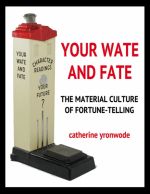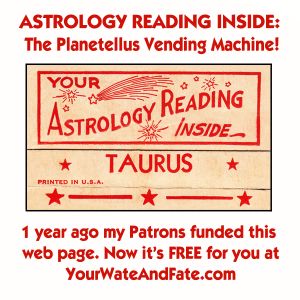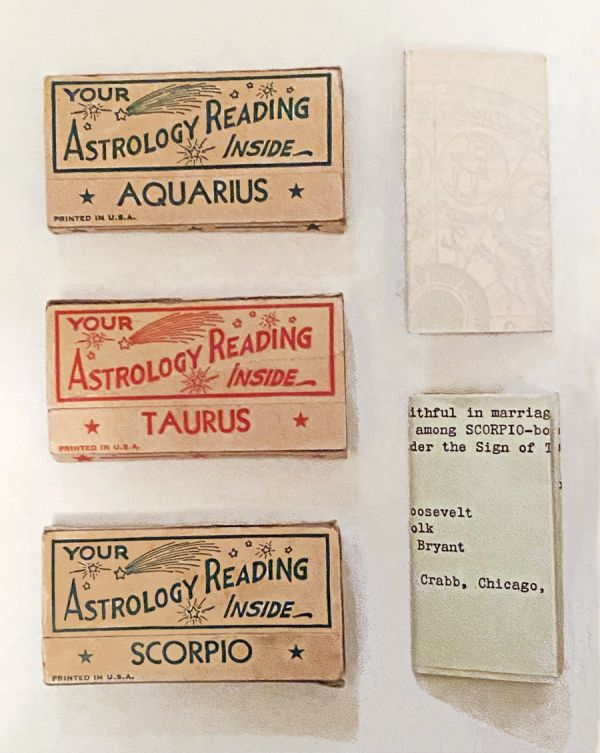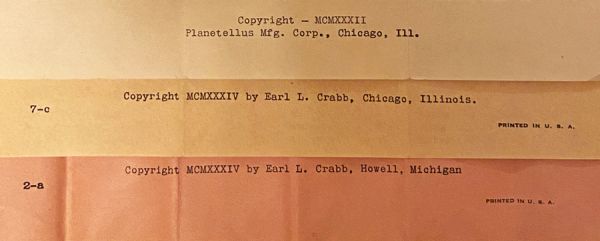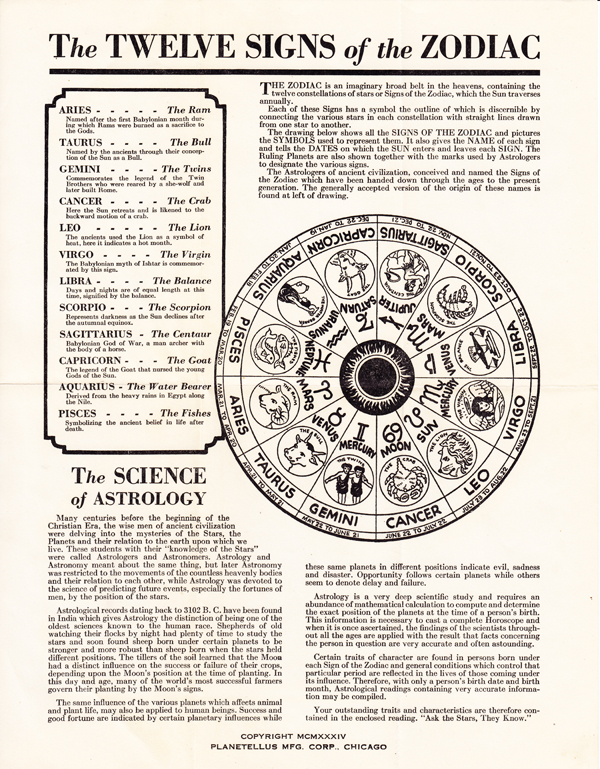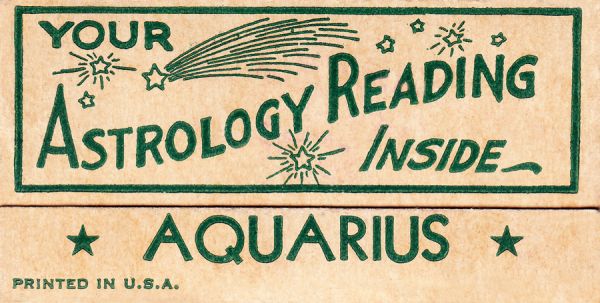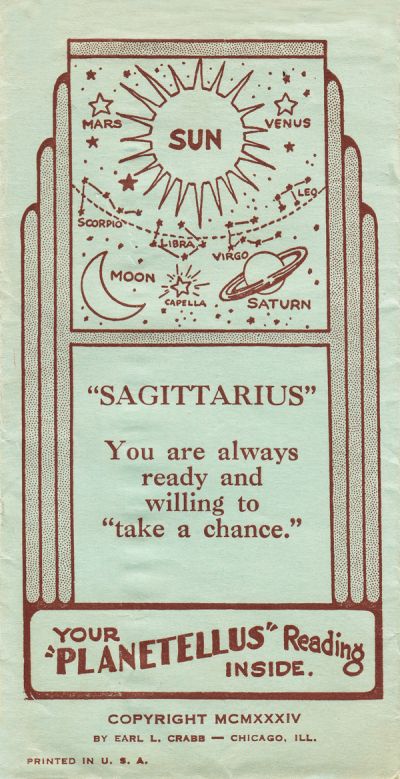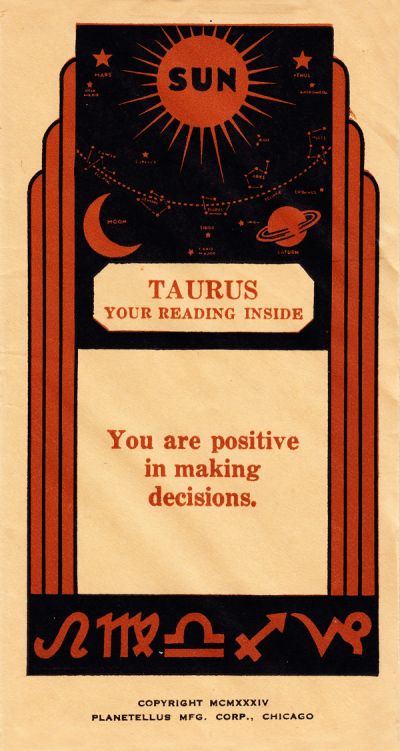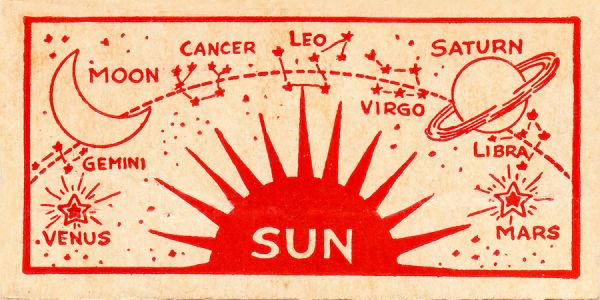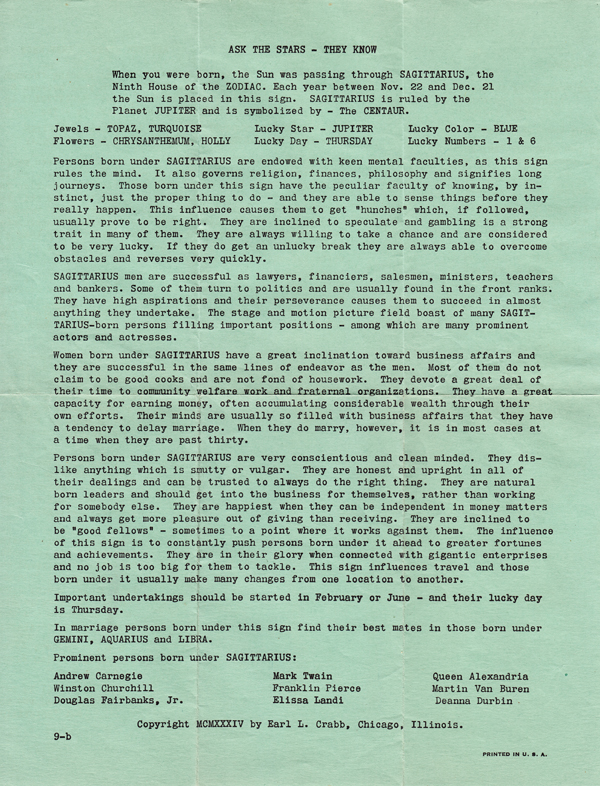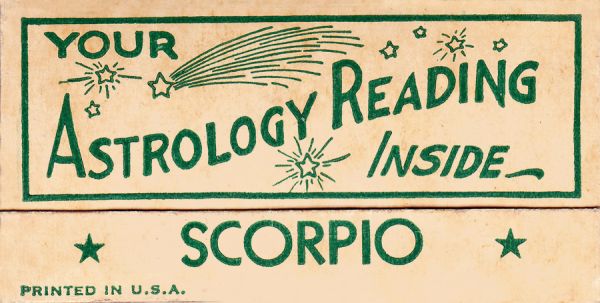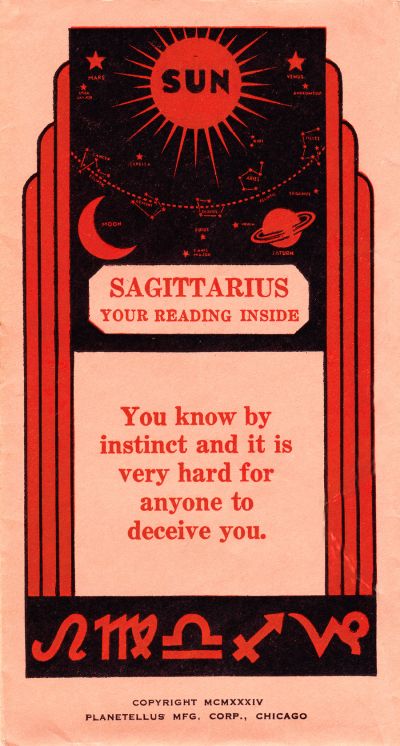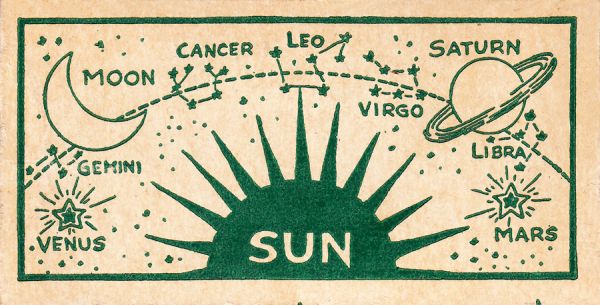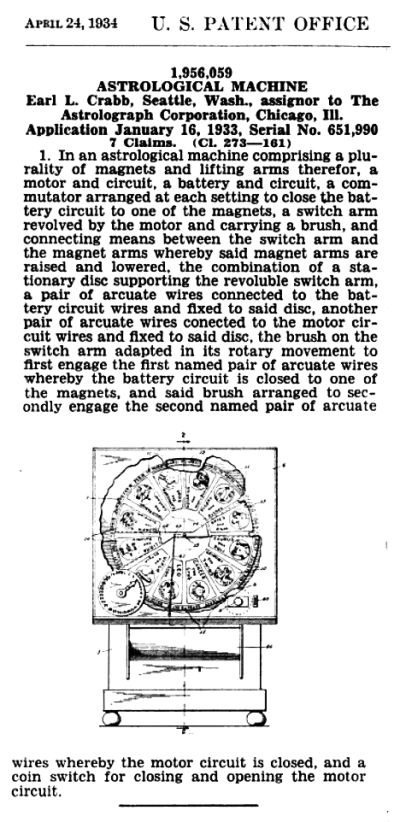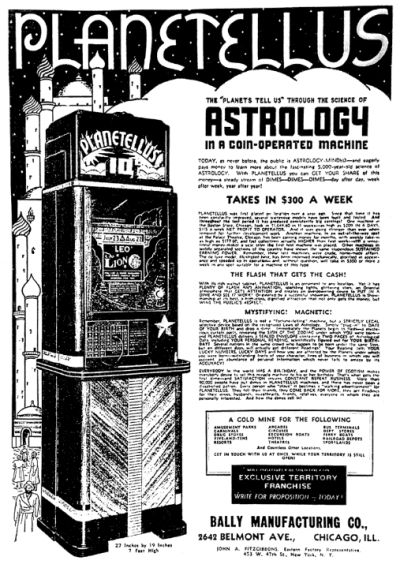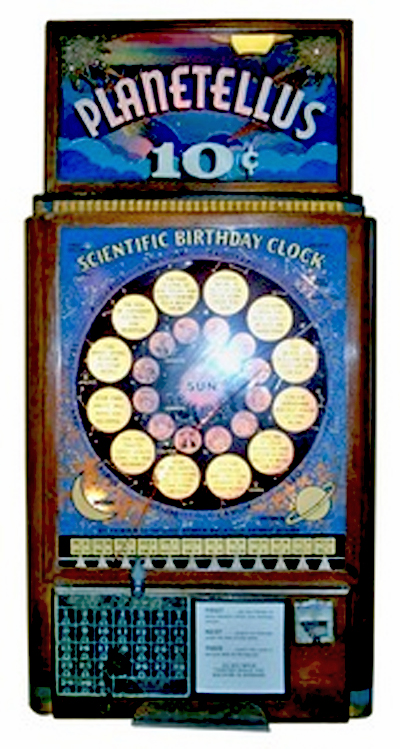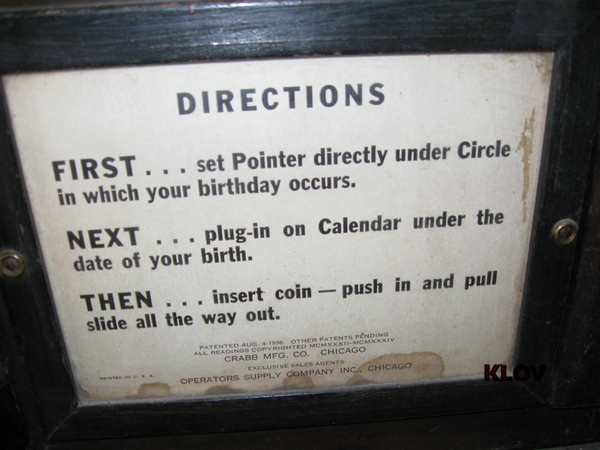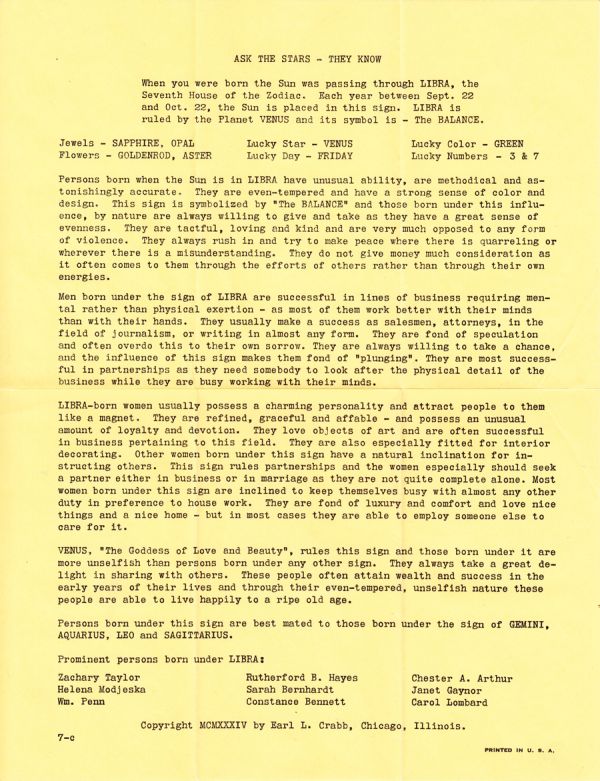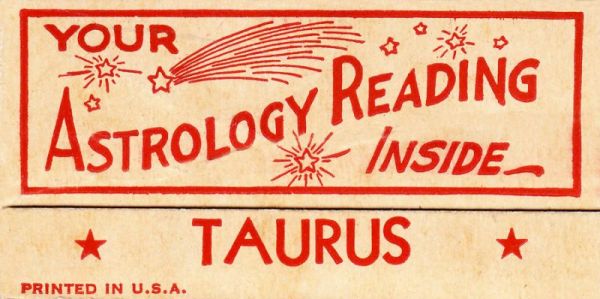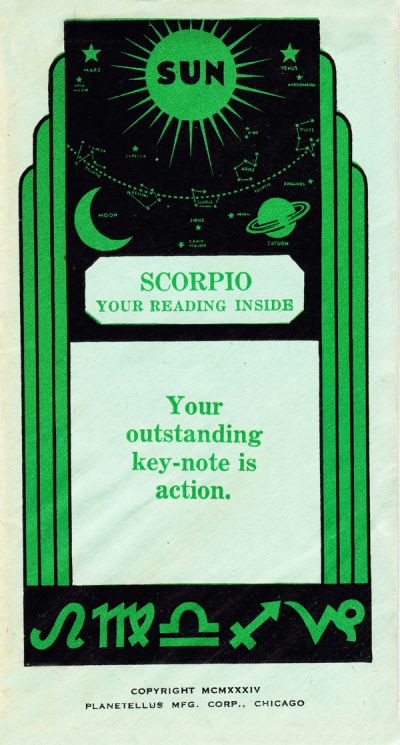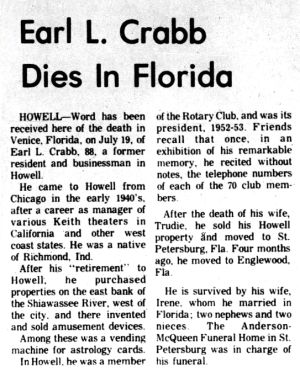Earl L. Crabb and the Planetellus Horoscope Vending Machine
In this installment of "Your Wate and Fate," we take a sneak-peek look at an upcoming page that will eventually be on display to the public. As a Patreon supporter, you have access to the page one full year before the public does.
- Patreon Release Date: November 7th, 2021
- Public Release Date: November 7th, 2022.
Please consider subscribing to my Patreon stream for $2.00 per week:
Support Your Wate and Fate
All of the material you have access to here -- the fabulous tea cups, the instructive booklets, the nostalgic postcards, the boldly graphic matchbook covers, and all of the historical information researched and shared from the mind of the woman who is making it all happen -- can easily fit into one 8 x 10 foot room in an old Victorian farmhouse, but you would never see it without the investment of the time it takes to produce such a site and the caloric input such a site requires in the form of food for the writer, graphic designer, and database manager, as well as the US currency needed to pay for the computers, software applications, scanners, electricity, and internet connectivity that bring it out of that little room and into the world. So, as you can see, this site is the darling of many, and it is growing at a rapid rate ... but although it is "free," there also is a cost. Your financial support underwrites this cost.
Automated Astrology
From 1910 through 1960, fortune teller machines were a common sight across America, from the Wate and Fate scale in your local Greyhound Bus station to the Exhibit Supply Company vending machine in the local bar that dispensed postcards showing hands of poker cards with their divinatory meanings. Astrological card vendors existed -- Exhibit Supply printed several series of them over the years -- but they were postcard-sized and only held the briefest of Sun-sign character analyses and a few correspondences to your sign's lucky day, gemstone, colour, and flower.
Meanwhile, under the fine example set by Professor A. F. Seward, World's Foremost Astrologer, travelling astrological lecturers spoke to seekers in theaters, in tents, in Spiritualist and New Thought churches, and from stages in amusement parks and seaside resorts. If you stayed for the lecture, then for 50 cents you could buy your yearly Sun-sign horoscope (and receive a coupon to have your full horoscope delineated by mail) -- or, for a dollar or two, you could purchase a complete book on astrology and teach yourself. Seward paved the way for three generations of peripatetic astrologers, who travelled regular routes through the Midwest, up and down the Pacific Coast, from the Catskills to the Poconos, or from Atlantic City to Coney Island, delivering a new horoscopic prediction for each Sun-sign, every year. While others came and went, Prof. Seward published twelve new multi-page astrological forecasts every year for more than 50 years.
Some astrologers followed in Seward's footsteps, but none of them had his stamina. They could not hit the road the way he did, meeting tens of thousands of people every year. The best many of them could do was stay at home and write a forecast for each Sun-sign for the year (or copy one by Seward if they were really low-class). They took out small ads in the occult and metaphysical magazines, and sent their mimeographed horoscopes to clients by mail order.
But what about the small towns, and the little restaurants where coin-operated vending machines dispensed gum balls and cigarettes -- and coin-operated juke boxes dispensed music on demand? Couldn't they have something better, something more like a real yearly horoscope for every sign of the zodiac, right there at the tavern or in the tea shop? Of course they could -- and it was Earl Leon Crabb, the genius behind the Astrograph, Astroscope, and Planetellus ("Planet Tell Us") vending machines, who put a yearly horoscope into the hands of every person in America with a dime to spare.
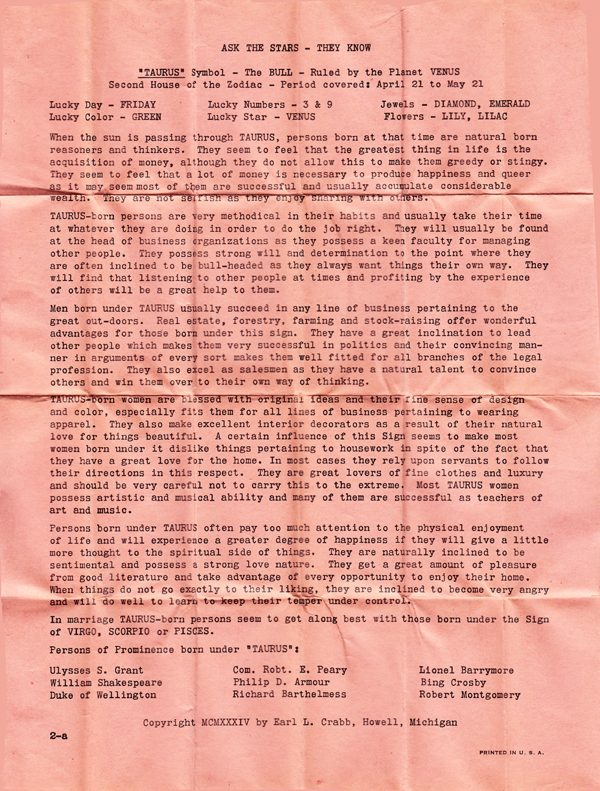
During Crabb's long career in the astrological vending machine business, the packaging for his Sun-sign fortunes went through several formats, from little chipboard boxes to two forms of colourful No. 6 size envelopes. Obviously the envelopes were dispensed from a different machine than the little boxes. Some were distributed from Chicago, Illinois, and some from Howell, Michigan. Some were copyright by the Planetellus Mfg. Corp. and others were copyright by Earl L. Crabb -- and these varied seemingly at random, because all three copyright notices are found on horoscopes vended in all three packaging styles. Furthermore, all of the horoscopes, no matter what shape or size, and no matter the address or company name, either bore the copyright date of 1932 or 1934, although Crabb continued to make them at least until 1965.
If you look closely at the three sheets of paper above, you will see that the first is dated to 1932 by Planetellus in Chicago, and is mimeographed. The second is dated to 1934, by Earl. L. Crabb in Chicago and is printed. The third is also dated to 1934, by Earl L. Crabb in Howell Michigan, and is printed. Crabb lived in Michigan for 24 years, from 1941 until his wife died, in 1965, and so, after two years with the 1932 copyright date, for the next 31 years he kept producing the yearly zodiacal readings with that same 1934 copyright date the entire time.
The top of these three sheets, from 1932, has no code at lower left, the other two do. The first digit in each one is the zodiac sign's number, where Aries is 1, Taurus is 2, Gemini is 3, and so forth. After that there is a letter. I believe this refers to the variations he made in the predictions. How many variants there were, i don't know, but the highest letter i have found is e, meaning that there were five variants. In my own collection i have three variants for Taurus, three for Libra,and two for Sagittarius. As was explained in the trade ad for the Planetellus machine, below, with this system, "Several persons in the same crowd who happen to be born under the same Sign, but on different days, will actually get different Readings!"
Every Planetellus reading consisted of two one-sided sheets of paper. The first was always on white paper, and was titled "The Twelve Signs of the Zodiac." The illustration was very nice, as was the lettering on the little boxes that held the folded horoscopes. Because Earl's brother, Cecil, gave his occupation as "Sign Painter" in the Federal Census of 1910 it is highly likely that he was responsible for the delightful sho-card lettering and art on the boxes and information sheet.
The second sheet in the reading was also one sided, and was mimeographed on a range of pale pastel writing papers -- pale yellow, ledger buff, pale orange, pale green, and pale blue. I have not found any rhyme or reason with respect to the colours of the papers and the zodiac signs or their date coding.
Who Was Earl. L. Crabb?
Here's what little i know about the man:
Earl Leon Crabb was born in Richmond, Indiana, on January 21, 1884. His father was James N. Crabb (1851-1916) and his mother was Sarah E. Myers Crabb (1856-1916).
Both of James' parents had been born in Indiana, and he was as well.
Sarah, who was also born in Indiana, was the daughter of Jacob Myers, a farmer, and Catherine Myers, who kept house. She was the youngest of four children; her siblings were Benjamin Myers, Samuel Myers, and Joseph Myers.
Earl was the third child of James and Sarah, and the story of their family begins before he was born.
1880
In the 1880 Federal Census the family lived at 149 South Franklin Street, Richmond, Wayne, Indiana, USA. In the home were:
- James Crabb, 29, Head of household, Occupation: "Butcher"
- Sarah Crabb, 23, Wife, worked in the home.
- Viola Crabb, 6, Daughter
- Nora Crabb, 5, Daughter
These two daughters, Viola and Nora, died young. The 1890 Census was lost in a fire, but if still alive then , they would have been 16 and 15 old, with Earl at age 6, and his younger brother Cecil under 1 year old -- however, by the time of the next census, in 1900, there was no trace of the daughters in the home.
1884
On the day that Earl was born, the Sun was at 1 degree Aquarius, giving him a love of invention, and it was conjunct Mercury at 28 degrees Capricorn, giving him the executive ability to carry his plans through to completion. His natal chart was graced by a beneficial grand trine in which five planets (Sun, Mercury, Uranus, Saturn, Pluto) were in five zodiacal signs (Taurus, Gemini, Virgo, Capricorn, Aquarius). This created an unusual interlinkage because four of the planets were in four signs ruled or co-ruled by other planets in the trine.
First, Earl's Sun in Aquarius (co-ruled by Saturn and Uranus) is conjunct Mercury in Capricorn (ruled by Saturn), trine Uranus (co-ruler of Aquarius) in Virgo (ruler of Mercury), making him quick at math and accountancy, and this is trine the conjunction of Pluto in Taurus and Saturn (co-ruler of Aquarius) in Gemini (ruler of Mercury), adding financial stubbornness and a sober but very quick mentality to his personality.
Not only that, a sextile links Pluto-Saturn and Uranus by way of Jupiter in Cancer, so we may consider him a pleasant family man -- but Jupiter is opposed to his Sun-Mercury, somewhat limiting his opportunities for wealth and yet forming the famed "kite" pattern, which always supports ambition, cleverness, and success. The fact that his jovial Jupiter is in Cancer and his surname was Crabb is the icing on the cake!
1900
In the 1900 Federal Census, the family consisted of James Crabb, 49 years old, Gertrude Crabb, 44 years old, Earl Crabb, 16 years old, and Cecil Duane Crabb, 10 years old, born 23 May 1890. They were living at 146 Vermont Street, Center Township, City of Indianapolis, Marion County, Indiana. James was no longer a butcher; now he was a "Canvasser."
Earl had gotten his first job at the age of 15 and had been employed as a "Clerk" in the local "Stenograph Store" for six months. Stenograph machines, invented in 1879 and still in use to this day, are employed by court reporters and other real-time transcriptionists. Earl was already beginning to demonstrate the interest in small moving mechanical metal parts that eventually led him into the vending machine business.
1903
At the age of 19, on October 5th, 1903, in Indianapolis, Marion County, Indiana, Earl was married to Gertrude "Trudie" Kantrowitz, a White female, who was also born in Indiana, in 1884 or 1885. Gertrude's father was Isaac Kantrowitz and her mother's surname was Oppenheim (a surname also found in my own Askenazi Jewish family, as it so happens). Both of Gertrude's parents had been born in Pennsylvania. The marriage garnered one line of type in the Indianapolis Journal newspaper for Tuesday, October 6th, 1903.
1904
In 1904, Earl and his father James were both listed in the City Directory for Indianapolis. James was an "Inventor," with an office at 1025 Stevenson Building, and Earl was a "mngr musical mdse" -- "Manager of a Musical Merchandise" concern (more small moving metal parts, and he probably got the gift from his father). They lived in the same home -- presumably with their wives and son Cecil -- at 513 East St. Clair Street, Indianapolis, Indiana.
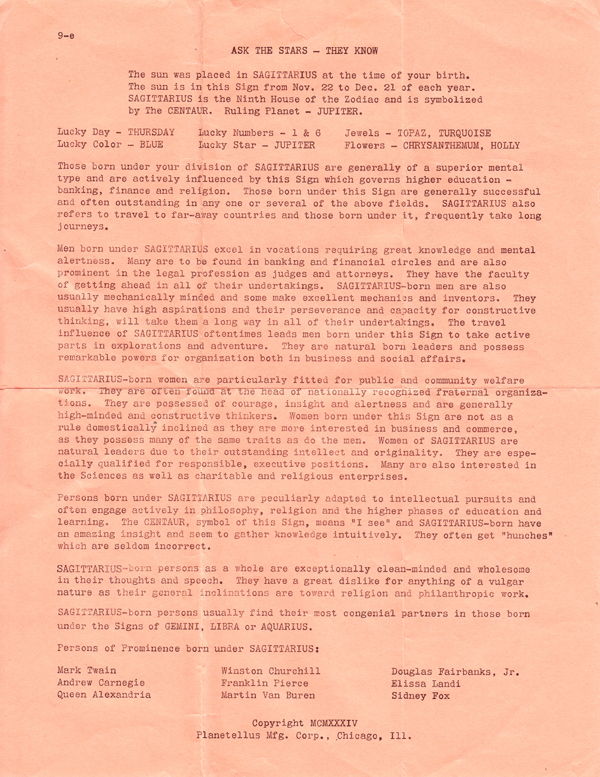
1908
In 1908, Earl L. Crabb, resident of Indianapolis, took out his first United States Patents for inventions:
- Repeating attachment for phonographs, filed August 14th.
- Combined picture exhibitor and phonograph, filed October 16th.
1910
In the 1910 Federal Census, Earl, age 26, and Gertrude, age 25, were living as lodgers in the home of George and Hilda Voelkenhauer and their son Carl at 812-18 Wilson Avenue, Chicago, Illinois. Earl was the "office manager" of a "moving picture" company. This would probably have also put him in a position to atttempt to martket his 1908 device for synchronizing photograph records with silent film projectons.
Meanwhile, back at 513 Saint Clair Street, Indianapolis, Ward 7, Marion County, Indiana, James had also changed his occupation: he was now a Real Estate Agent, while Cecil was still in the home at the age of 19, giving his occupation as Sign Painter on his Own Account, that is, self-employed.
1916
James died in 1916, aged 64-65, and was buried in Crown Hill Cemetery, Centerville, Wayne County, Indiana, Sarah died the same year, 1916, aged 59–60, and was buried beside him in Crown Hill Cemetery, Centerville, Wayne County, Indiana.
1917
When Earl Leon Crabb went in for his World War I Draft Registration in 1917-1918, his street address was Carlton Court C 15, Buffalo, Erie County, New York. His spouse was Gertrude Crabb, his race wad White, and it was noted that his physical build was Slender, his height was Medium, his hair colour was Light Brown, and his eye colour was Grey.
1920
In the 1920 Federal Census, Earl, age 35, and Gertrude, age 35, were enumerated as "boarders" in the home of William and Else Beardsley at 600 Academy Street in Manhattan, New York City, New York. Earl's occupation was "Actor, Film," and Gertrude did not work outside the home.
This career move seems to not have panned out, because IMDb lists no films with Earl Crabb in them from the 1920s -- and in any case, the couple soon moved to Seattle, probably in 1927, according the timeline established by the dated magazine article below.
1930
In the 1930 Federal census Earl and Gertrude were living in an apartment in Seattle. His occupation was "Theatre Manager." Later articles and his obituary indicate that he was the northwest zone manager for Fox West Coast Theatres and then later was a manager for the Keith-Albee-Orpheum Corporation, which operated a chain of vaudeville and motion picture theatres.
In Late August, 1930, a shocking and tragic event occurred at Earl's workplace:
"Variety" Magazine reported the story on Wednesday, September 3rd, 1930
Syn McDonald Suicide; First Phoned Wife
Seattle, Sept. 2.
Syn McDonald, assistant to Earl Crabb, northwest zone manager for Fox West Coast Theatres, committed suicide by taking arsenic late last week, in a fit of despondency over ill health.
McDonald had called his wife on the phone while she was in Dallas and told her he was about to take poison. He then hung up the receiver.
Mrs. McDonald phoned to a physician In Seattle, but he found the theatre man too late. McDonald was 60 years old and had been assistant to the district manager here for three years. He was well liked.
1931
In 1931, the J. P. Seeburg Company, a manufacturer of jukeboxes, commenced the manufacture of the Astrolograph machine. Its name appears on a list of machines manufactured between 1931-1939 which was published in the January 1940 issue of the Coin Machine Journal. The working parts and design of the machine were devised by Earl L. Crabb, living in Seattle, Washington. The next year, he sold and assigned his patent to the Astrolograph Corporation, a division of J. P. Seeburg. The sale of this patent seems to have enabled him and Trudie to move to Chicago, Illinois.
1932
In 1932, Crabb founded his own Planetellus vending machine company to supply astrological readings automatically, and he copyrighted his texts. The first Planetellus machine he designed vended a reading that consisted of two sheets of letter-size paper folded down into tiny rectangles that fit into little open-ended boxes. Earl and Trudie were living in Chicago, Illinois at the time, according to the publication data on the paper sheets which bear the 1932 copyright notice.
1934
In 1934, Crabb was listed in United States Patent Office records as the official "assignor" of his astrological machine patent to the Astrolograph Corporation; note that his address was given as Seattle, Washington, although by that time he and Trudie were living in Chicago, and had been since 1932.
Crabb, Earl L., Seattle, Wash., assignor to The Astrolograph Corporation, Chicago, 111. Astrological machine. 1,956,059 ; Apr. 24.
Later in 1934, presumably because he had sold the patent rights for this machine to the Astrolograph Corporation of J. P. Seeburg, Crabb re-copyrighted his own horoscope readings and packaging, and the "type one" Planetellus envelope was introduced. This meant that he was operating two kinds of machines, one for the little boxes and one for the envelopes. The contents were the same in each; only the packaging varied.
1935
In 1935 Crabb licensed the Planetellus apparatus to Bally, a slot machine and pinball company that had been founded in 1932. The first Bally Planetellus machine was on the market in August, 1935.
The Planetellus cabinet was in three parts and stood 7 feet high, 27 inches wide, and 19 inches deep. This model delivered enelopes. The selection was made for a birth month, then the birth date was selected, the coin slider was pushed in, a curtain opened, reealing the zodiac sign for that date, and the horoscope was delivered in a sealed envelope.
The very first Planetellus machine was installed in the lobby of a Keith theatre in Washington, D. C., the Keith chain being Earl Crabb's old employer. The fine cabinetry, large size, and esoteric nature of the product limited the machine to high-class venues like theatre lobbies and department stores, but models were quickly installed in Detroit, New York City, and Chicago. About 800 Planetellus machines were made by Bally.
This is my best attempt at deciphering the tiny type in the above ad:
PLANETELLUS
THE "PLANETS TELL US" THROUGH THE SCIENCE OF ASTROLOGY IN A COIN-OPERATED MACHINE
TODAY as never before, the public is ASTOLOGY-MINDED - and eagerly pays money to learn more about the fascinating 5,000-year-old science of ASTROLOGY. With PLANETELLUS you can GET YOUR SHARE of this money - a steady stream of DIMES - DIMES - DIMES - day after day, week after week, year after year!
TAKES IN $300 A WEEK
PLANETELLUS was test-placed on locations over a year ago. Since that time it has been completely improved because several models have been built and tested. And throughout the test period it has generated consistently big earnings! One machine in the Boston Store, Chicago, took in $11,545.40 in 11 weeks, earning as high as $709 in 4 DAYS, $115 a week NET PROFIT TO OPERATOR. And it was going stronger than ever when removed for further development work. Another machine, in an out-of-the-way spot at the Palace Theatre, Chicago, has been coining money for months with weekly take-ins as high as $111.00 and last collections actually HIGHER than first week - still a winning money-maker since the first test machine was placed. Other machines in widely separated sections of the country have shown the same stupendous SUSTAINED EARNING POWER. Remember, these first machines were crude home-made affairs. The 96" high model illustrated here has been improved mechanically, glorified in appearance, and simplified in its operation and without question, will take in $300 or more a week in any spot suitable for a machine of this type.
THE FLASH THAT GETS THE CASH
With its rich walnut cabinet, PLANETELLUS is an ornament to any location. Yet it has PLENTY OF FLASH AND ANIMATION - sparkling lights, glittering stars, an Oriental atmosphere that GETS ATTENTION and creates an overwhelming desire to PUT IN A DIME AND SEE IT WORK! Operated by a principle unknown, PLANETELLUS is showmanship at its best, a high-class, dignified attraction that not only gets the money, but WINS THE PUBLIC'S RESPECT!
MYSTIFYING! MAGNETIC!
Remember, PLANETELLUS is not a fortune-telling machine, but a STRICTLY LEGAL selective device based on the recognized Laws of Astrology. Simply "plug in" DATE OF YOUR BIRTH and drop a dime - immediately the Planets begin to flash and the mysterious curtain parts, revealing the SIGN OF THE ZODIAC under which YOU were born - and PLANETELLUS delivers a SEALED ENVELOPE containing TWO PAGES of Astrological Data, including YOUR PERSONAL READING scientifically figured out for YOUR BIRTHDAY! Several persons in the same crowd who happen to be born under the same Sign, but on different days, will actually get different Readings! Your Reading with YOUR LUCKY NUMBERS, LUCKY DAYS, and how you are affected by the Planets under which you were born - outstanding traits of your character, days of fortune on which you will succeed, an abundance of personal information which never fails to amaze by its ACCURACY!
EVERYBODY in the world HAS A BIRTHDAY, and the POWER OF EGOTISM makes everybody desire to see this miracle machine pick his or her Birthday. That's what gets the first dime - and SATISFACTION engenders CONSTANT REPEAT BUSINESS. More than 90,000 people have put dimes in PLANETELLUS machines and there has never been a dissatisfied patron. Every person who "plugs in" becomes a "walking advertisement" for PLANETELLUS. They tell their friends, they COME BACK FOR MORE. They get Readings for their wives, husbands, sweethearts, daughters, relatives, everyone in whom they are personally interested. And how the dimes roll in!
A GOLD MINE FOR THE FOLLOWING:
Amusement Parks, Arcades, Bus Terminals, Carnivals, Circuses, Dept. Stores, Drug Stores, Excursion Boats, Ferry Boats, Five-and-Dimes, Hotels, Railroad Depots, Resorts, Theatres, Sportlands, And Countless Other Locations.
GET IN TOUCH WITH US AT ONCE, WHILE YOUR TERRITORY IS STILL OPEN! Big opportunities for operators with exclusive territory franchise. Write for propositions - Today!
Bally Manufacturing Co., 2642 Belmont Ave., Chicago, ILL.
John A. Fitzgibbons, Eastern Factory Representative. 453 W. 47th St., New York, N.Y.
1936
When Social Security Cards were first issued, in 1936, Earl and Gertrude were living in Illinois, as both of their cards were issued in that state.
By now the second-generation Planetellus machines by Bally had hit the streets. Instead of the pop-up sign of the zodiac revealed by parting curtains, this model features 12 circles on painted glass, with a light bulb behind each circle, in the form of a "Scientific Birthday Clock." You use the sliding pointer to select your birth-month, plug in the month-date, insert a dime in the slider, push it in, your zodiac circle flashes and lights up, the stars twinkle, and you receive your sealed Planetellus horoscope.
1939
In 1939 the Crabb Manufacturing Co. released an astrological vending machine that gave out cards. It was marketed as the Astroscope Birthday Horoscope machine. These "cards" may have been the size of a postcard, they may also have vended the envelope-style horoscopes shown on this page. According to the International Arcade Museum, Crabb Manufacturing Co. released 2 different machines under this trade name, starting in 1939.
1940
In the 1940 Federal Census, Earl and Gertrude were living at 4512 North Winchester, in Chicago, Illinois. The apartment building they lived in contained six units, and they has been living in Chicago in 1935, but not at that address. Earl listed his occupation as "Proprietor, Vending Machine Manufacture" and stated that he did not earn his income from wages, but as profits from his own entrepreneurial activities.
1941
This is the approximate year that Earl and Trudie Crabb moved to Howell, Michigan, where Earl continued to manufacture, and sell his astrology vending machines. He was 57 years old and Trudie was 56. Trudie presumably was the company's bookkeeper, for she was listed as such at the next Federal Census, in 1950.
1950
In the 1950 Federal Census, Earl and Trudie were in Howell, Livingston County, Michigan. The land was described as a "Farm," meaning that it was in a rural area, but Earl's occupation was "Executive and Sales Manager, Manufacturing Weighing Machines." He was 66 years old and was "Working In Own Business," while Trudie, 65 years old, was a "Bookkeeper; Manufacturing Weighing Machines."
The coupling of a "weighing machine" or scale with his little astrology boxes, cards, and envelopes indicates that Earl was manufacturing scales that doubled as vending machines. You stood on the scale platform, put your coin into a coin-slide, selected a month-slot, plugged a jack into the month-date, pushed in the slide and pulled it back out. A window opened to show your weight, and a small zodiac box or envelope was revealed on the metal slide for you to receive. Such machines are at the heart of "Your Wate and Fate," the concept at the core of this web site.
1953
Earl's brother Cecil Duane Crabb died in 1953, aged 62–63. He was buried in the family plot in Crown Hill Cemetery, Indianapolis, Marion County, Indiana.
1965
In October 7th, 1965, Gertrude "Trudie" Kantrowitz Crabb died at her home at the age of 81. Born in Indiana, she had been a resident of Howell, Michigan, for 24 years. She was survived by her husband, Earl L., and by her sister Julia Kantrowitz Nachman of Detroit, Michigan.
1966
Shortly after Gertrude's death, Earl, who was then in his early 80s, left Michigan for St. Petersburg, Florida, where he met and married a woman named Irene. They later moved to Englewood, Florida.
1972
Earl Leon Crabb died on July 19th, 1972, at the age of 88. His last residence was in Englewood, Sarasota County, Florida. His obituary noted that he had invented machines that dispensed astrology readings.
And Onward...
Earl and Trudie never had children, nor did he and his late-in-life wife Irene. The surviving nephews and nieces mentioned in his obituary were the children of his brother Cecil. Here is their genealogy, for family members who may be curious about their great or great-great uncle:
Cecil Duane Crabb married twice, to:
- Ethlene Griffing Crabb (1889–1975) in 1912; they divorced before 1925.
- Cecil's children with Ethlene were:
- * James N. Crabb, born in Indianapolis, Marion County, Indiana, USA
- * Cecil D. Crabb (Jr.), Brig. Gen., born in Indianapolis, Marion County, Indiana, USA
- Stella Seidensticker Crabb (unknown–1936; they were married before 1925.
- Cecil's children with Stella were:
- * Jane Crabb Queisser, (February 23rd, 1914 - October 28th, 1979); born in Indianapolis, Marion County, Indiana; died at age 65; buried in Crown Hill Cemetery, Indianapolis, Marion County, Indiana.
- * Rosalyn C "Roz" Crabb Stone (December 8th, 1925 - February 10th, 2010; born in Indianapolis, Marion County, Indiana; died at age 84; buried in Crown Hill Cemetery, Indianapolis, Marion County, Indiana.
Rosalyn Stone's obituary identifies additional members of the family:
"Roz" C. Stone 84, Indianapolis, passed away on February 10, 2010. She was born in Indianapolis on December 8th, 1925 to the late Cecil and Stella Seidensticker Crabb. She is survived by her husband of 59 years, Raymond M. Stone. She was the loving mother of 4 children, James Stone (wife Catherine), Jeffry Stone (wife Susan) Katherine Stone (husband Eugene Tonetti) and Robert Stone (wife Elizabeth) and is also survived by 11 grandchildren and 4 great-grandchildren, and 2 brothers, James N. Crabb and Cecil D. Crabb. Mrs. Stone graduated from Shortridge High School in 1944 and went on to graduate from Butler University with a B.A. in Business in 1949. While at Butler, she became a member of the Butler chapter of the Pi Beta Phi sorority. She later joined the Indianapolis Day Nursery auxiliary and The St. Margaret's Hospital Guild. Roz was a member of Epworth United Methodist Church and participated in several of the women's ministries there. Roz loved to play and watch sports, and was accomplished in golf and tennis. She loved playing bridge, and working crossword puzzles. She was a wonderful cook and party giver who loved to entertain and make people happy.
An American Original
Earl Crabb's training in astrology -- if any -- was simple and pragmatic. He was primarily a mechanical inventor, and his Sun-sign character analyses may well have been cobbled together from the writing of Professor Alfred F. Seward or other authors. He apparently did not cast natal horoscopes for clients, create astrological talismans, or lecture on the subject of the stars. What he did was bring astrology to the masses via his machines, the Astrolograph, Astroscope, Planetellus, and other products of the Crabb Manufacturing Co. In the era of Henry Ford's automobile production lines and the Horn & Hardart Automat cafeterias, it seemed only natural to drop a coin into a slot and be served up some basic astrological knowledge about yourself -- and for 33 years, Earl and Trudie's two-person company did just that.
Thus ends the story of the inventor and astrologer Earl Leon Crabb, the man who automated astrology!
catherine yronwode
curator, historian, and docent
Your Wate and Fate
Special thanks to my dear husband and creative partner nagasiva yronwode for illustrations, scans, and clean-ups.
